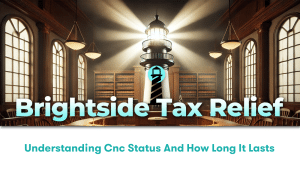Understanding the Basics of an Offer in Compromise
An Offer in Compromise (OIC) presents a viable option for taxpayers struggling with substantial federal tax debt that they can’t fully pay. Provided by the IRS, it offers taxpayers an avenue to settle their tax debt for less than the total amount they owe. This method is considered beneficial by many taxpayers and is often regarded as a lifeline to those in difficult financial situations. At Brightside Tax Relief LLC, we understand how overwhelming tax debt can be and how it can hamper your future financial stability.
Primarily, the IRS will only consider an OIC under specific circumstances. These include if there’s a genuine doubt as to the full amount of the tax liability or doubt about the collectability, or if it’s established that collecting the full debt would create an unfair economic hardship or would be inequitable or unfair for reasons such as health, age, or income. But to successfully submit and get approval for an OIC, there are essential steps to follow, and that’s where Brightside Tax Relief LLC comes in.
The Initial Evaluation for an Offer in Compromise
Before proceeding with an OIC, it’s necessary to determine your eligibility. The IRS provides a pre-qualifier tool to help taxpayers ascertain whether they’re eligible or not. However, passing the pre-qualifier tool doesn’t guarantee the IRS’s acceptance of the OIC. Proper representation by experienced tax professionals, like our team at Brightside Tax Relief LLC, can significantly increase the chances of getting your OIC accepted.
Compiling a Complete Offer Package
Providing a properly completed offer package is essential in your OIC application process. This typically includes:
– Form 656 or the OIC
– Form 433-A (OIC) or Form 433-B (OIC) which contain a detailed financial statement for individual taxpayers or businesses respectively
– A non-refundable payment including the OIC application fee and the initial payment towards your tax debt
Navigating the IRS Offer in Compromise Process
Upon receipt of your offer package, the IRS will review your proposed OIC. This process may take several months due to the detailed financial analysis involved. It may involve close scrutiny of your income, expenses, ability to pay, asset equity, and future income. Having a tax professional with you in this process can provide significant insights on your likelihood of acceptance and potentially streamline the process. If the IRS rejects your offer, they will send a letter detailing the reasons behind this decision. However, this is not the end of the road. You have the right to appeal this decision within 30 days.
Making the Offer in Compromise Payment
Accepted OICs come with a payment option chosen by the taxpayer when the offer is submitted. You can choose to pay in a lump sum, which includes a payment of 20% of the total offer amount, followed by the balance within five or fewer payments. On the other hand, you can opt for a periodic payment offer, which includes the first payment followed by monthly payments while the IRS considers your offer. Upon acceptance, all terms of your OIC need to be met.
Understanding the Consequences of an Offer in Compromise
While an OIC can be an excellent option for many, it’s important to understand its potential impacts. Any federal tax liens against you aren’t removed until the full offer amount has been paid. Additionally, the IRS can revoke your OIC if you fail to fulfill all terms, remain compliant with tax obligations or false information was provided or important details were left out in your OIC application.
Role of Professional Consultation in an Offer in Compromise
Navigating the complex avenues of an OIC can be a daunting task. However, the guidance of a professional tax relief agency like Brightside Tax Relief LLC can notably simplify this process. Our team of experienced tax professionals will help you determine your eligibility, complete your application, and guide you through IRS negotiations. They can also advise on other tax relief options available to you if an OIC is not your best option. Remember, when it comes to an OIC, it’s not just about submitting an offer; it’s about crafting a successful offer that the IRS will accept. Learn more about this from the IRS OIC page on their website.
In conclusion, the journey towards a successful OIC application might not be an easy one. It may be fraught with complexities and setbacks. However, by understanding the process, working with a professional tax firm like Brightside Tax Relief LLC, and staying committed, your chances of successfully reducing your tax debt through an OIC becomes significantly heightened. As much as the process might be complex, it is often worth it. The brighter side of your financial future might just be an Offer in Compromise away.




